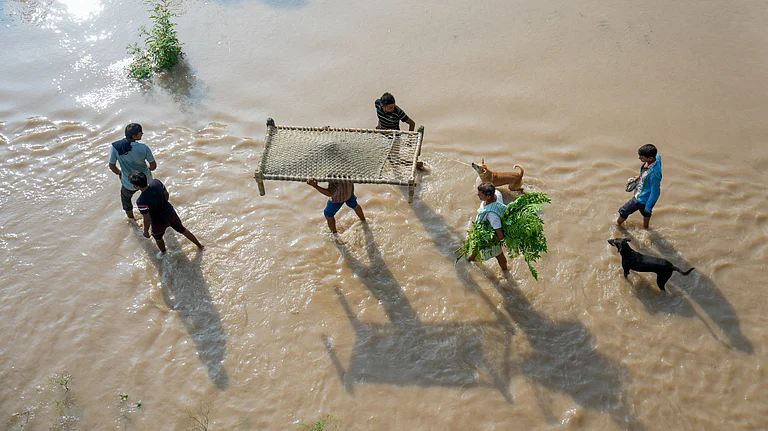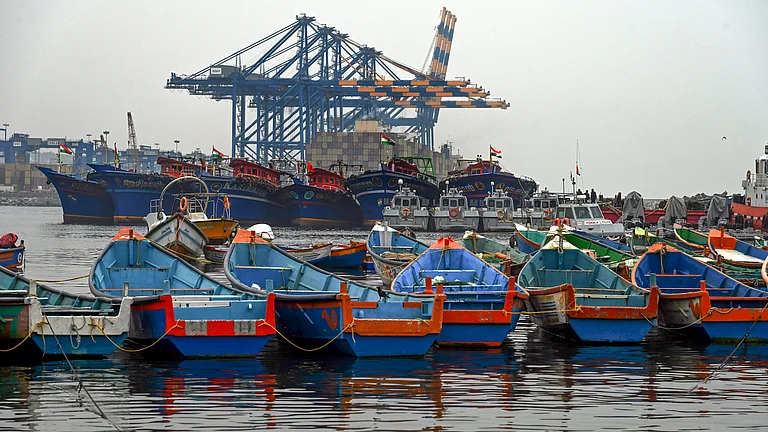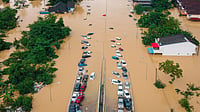
India issues warning to Pakistan on humanitarian grounds over flooding from water from dams.
Over 150,000 people evacuated from vulnerable areas in Pakistan’s Punjab province.
Heavy monsoon rains and rising rivers intensify cross-border flood threats
India has issued fresh alerts to Pakistan about the “high probability” of flooding in the Tawi river, with relentless rainfall in the northern states forcing the release of excess water from major dams.
The alerts, sent to Islamabad through the Ministry of External Affairs, were issued on “humanitarian grounds”, the sources told PTI. Pakistan subsequently issued an alert for flooding on three rivers which flow into the country from India.
According to ET, more than 150,000 people have been evacuated from villages in Pakistan’s Punjab proving so far, after India released water from overflowing dams into cross-border rivers, official said on August 26.
The move has caused fears of “very high to exceptionally high” flooding, coming on top of weeks of heavy monsoon rains that have killed over 800 people in Pakistan since late June, reported AFP.
"The flood situation is grave," Irfan Ali Kathia, an official at the authority in Punjab told Reuters on August 26. "The next 48 hours will be critical," he added.
Pakistan’s National Disaster Management Authority (NDMA) told Al Jazeera that it had issued an advance alert to officials in Punjab province about a surge in the Sutlej River and the risk of flooding and asserted that evacuations were underway. In a statement, it said rescuers evacuated more than 14,000 people from Kasur, while about 89,000 were moved to safer ground from the city of Bahawalnagar, near the border with India, reported Al Jazeera.
The first alert was issued on August 25. “We issued another alert yesterday (Tuesday) and one today (Wednesday) of high probability of flooding in the Tawi river. The gates of some dams had to be opened due to excessive rains being witnessed in Indian regions,” a source told PTI.
Alerts, Evacuations, Rising Rivers
The Tawi river originates in the Himalayas and passes through the Jammu division before joining the Chenab in Pakistan.
India halted the regular exchange of hydrological data with Pakistan under the terms of Indus Water Treaty after 26 people, mostly tourists, were killed in Jammu Kashmir’s Pahalgam by Pakistan terrorists on April 22.
Despite the suspension, the fresh food warnings were communicated to avoid the loss of life and property across the border, the sources confirmed to PTI.
In Punjab, the Sutlej, Beas and Ravi rivers and seasonal rivulets are in spate because of heavy rainfall in their catchment areas.
Jammu has also been reeling under incessant rains, causing rivers to overflow. With water levels increasing beyond safe limits, the authorities were compelled to open the sluice gates of key reservoirs.
The Indus Waters Treaty, signed in 1960 and brokered by the World Bank, has long governed the sharing of river waters between India and Pakistan.
What’s Behind the Floods in Pakistan?
The exact cause of the floods has not been revealed as per reports, however, the several factors that led to the existing deluge include intense monsoon rains, climate change, urbanisation, deforestation, poor infrastructure to name a few.
While releasing about 200,000 cusecs of water (A cusec is a volume equivalent to one cubic foot, or 28 cubic litres, per second) does put the region under an “exceptionally high” risk of flooding, according to Reuters, experts have underscored that the pre-existing deluge is taking place due to climate change.
“While climate change plays a critical role in intensifying flooding events in Pakistan, other factors such as urbanisation, deforestation, inadequate infrastructure, and poor river management also contribute significantly,” Ayyoob Sharifi, a professor at Hiroshima University in Japan, told Al Jazeera.
Sharifi told Al Jazeera that climate change is intensifying monsoon rainfall, causing more frequent extreme precipitation events.
(With inputs from PTI.)

































